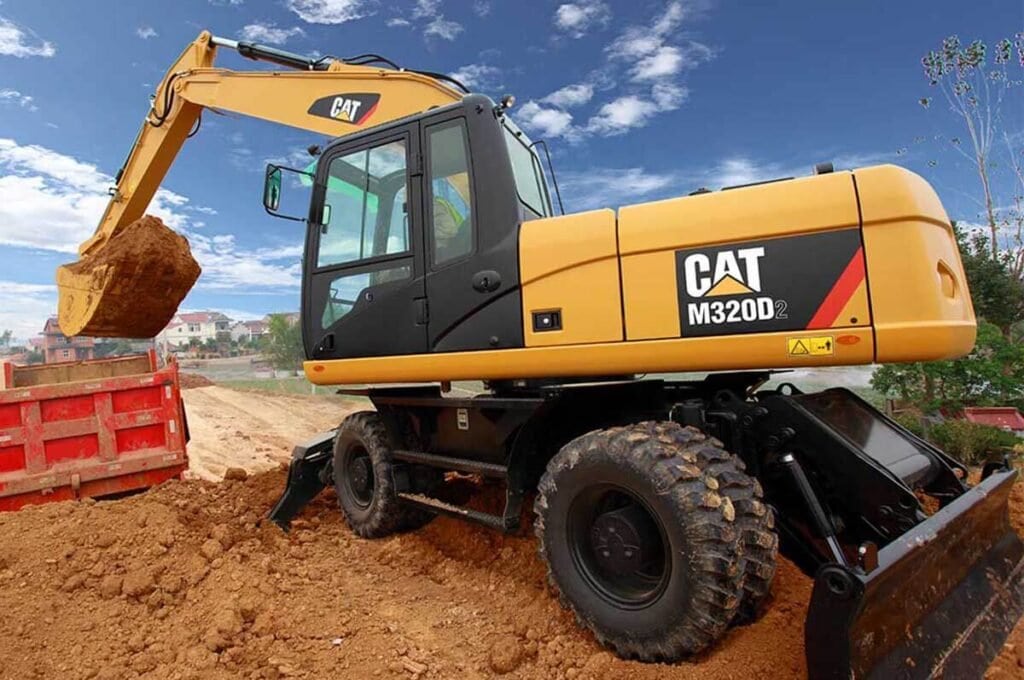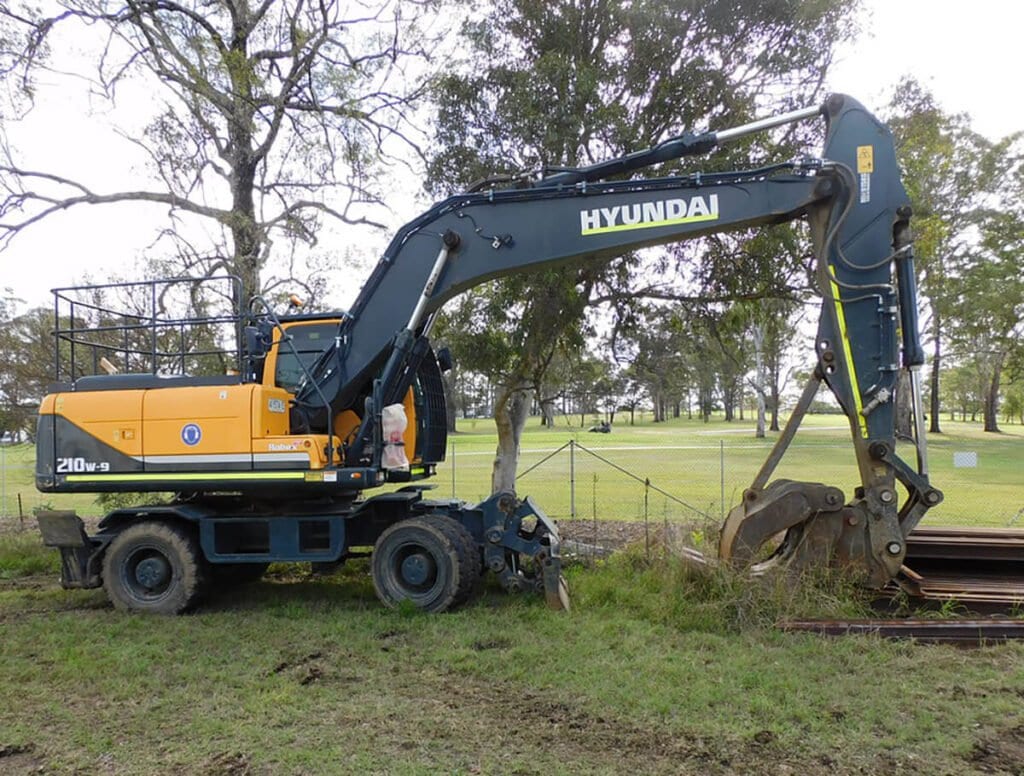
Introducción
Wheeled excavator are indispensable tools in construction, demolition, landscaping, and many other industries. Their mobility and versatility set them apart from track-type excavators, making them ideal for projects requiring quick movement and agility. In this comprehensive guide, we will explore the features, benefits, and common uses of wheeled excavators, as well as highlight some of the leading models currently available on the market.
At HIOSEN, we understand the importance of having reliable and cost-effective machinery for your construction and earthmoving projects. One of the most versatile pieces of equipment that we offer is the used wheeled excavator. These machines are renowned for their mobility, versatility, and efficiency, making them a popular choice for a wide range of applications. In this guide, we will delve into the features, benefits, and specifications of three of our most popular models: the Hyundai R210W-9, CAT 315D, and SANY SY155W. Whether you’re searching for a “used wheel excavator” or a “wheeled excavator for sale,” this guide will provide valuable insights to help you make an informed decision.

What Is a Wheeled Excavator?
A wheeled excavator, also known as a wheel excavator, is a heavy construction vehicle designed for mobility and flexibility. Unlike tracked excavators, wheeled excavators have wheels instead of tracks, allowing them to travel at higher speeds and operate on a variety of terrains, including paved roads. This feature makes them ideal for projects that require frequent relocation and for working in urban environments.
Key Features of Wheeled Excavators
Wheeled excavators share many features with their tracked counterparts, but there are some key differences that make them stand out:
- Velocidad de viaje: Wheeled excavators can travel at higher speeds, making them more efficient for moving around a site or traveling on roads.
- Mobility: Wheels provide better traction on paved surfaces and reduce ground disturbance, making them suitable for urban environments.
- Versatilidad: They can be equipped with a variety of attachments, such as buckets, hammers, and grapples, to perform multiple tasks.
- Peso: Generally lighter than tracked excavators, they cause less damage to finished surfaces and require less effort to transport.
- Mantenimiento: Wheels are often easier to maintain than tracks, reducing downtime and maintenance costs.
Applications of Wheeled Excavators
The versatility of wheeled excavators makes them suitable for a wide range of applications, including:
- Road Construction: Their ability to move quickly between sites and dig trenches for utilities and pipelines makes them ideal for road construction projects.
- Demolición: Equipped with specialized attachments like hydraulic breakers, wheeled excavators can efficiently demolish structures and clear debris.
- paisajismo: They are useful for grading, trenching, and planting trees, thanks to their maneuverability and precision.
- Trabajo de servicios públicos: Digging trenches for cable and pipe installations, as well as general excavation work, are typical uses.
- Residential Construction: For building foundations, driveways, and other small-scale construction projects.
Benefits of Used Wheeled Excavators
When considering a “wheeled excavator for sale,” there are several compelling reasons to choose a used model:
- Ahorro de costes: Purchasing a used wheeled excavator offers significant savings compared to buying new.
- Fiabilidad: Many used wheeled excavators have been well maintained and offer reliable performance.
- Versatilidad: Wheeled excavators are adaptable and can be used for a variety of tasks, including digging, loading, and demolition.
- Mobility: The ability to travel at higher speeds and on various surfaces makes wheeled excavators ideal for jobs that require frequent relocation.
- Ease of Transport: Wheeled excavators can often be driven directly to the job site, eliminating the need for specialized transportation.
HIOSEN’s Top Models: Hyundai R210W-9, CAT 315D, and SANY SY155W
Let’s take a closer look at the specifications, features, and benefits of these three popular models.
Hyundai R210W-9
Descripción

The Hyundai R210W-9 is a highly regarded wheeled excavator known for its robust design and efficient performance. Ideal for a range of applications, this machine is particularly suited for construction, demolition, and landscaping projects.
Características clave
- Motor: 148 hp, Tier 3 compliant
- Velocidad de viaje: Up to 25 mph (40 km/h)
- Capacidad del cucharón: 0.56 – 1.26 cubic yards
- Peso operativo: 47,600 lbs (21,600 kg)
- Alcanzar: Up to 21 feet (6.4 meters)
Benefits
- Eficiencia de combustible: Advanced engine technology reduces fuel consumption.
- Comodidad del operador: Spacious cab with air conditioning and comfortable seating.
- Mantenimiento: Easy access to service points for quick maintenance.
CAT 315D
Descripción

The CAT 315D is a highly versatile wheeled excavator designed for durability and reliability. Its robust construction and powerful performance make it a favorite among construction professionals.
Características clave
- Motor: 136 hp, Tier 3 compliant
- Velocidad de viaje: Up to 22 mph (35 km/h)
- Capacidad del cucharón: 0.5 – 1.2 cubic yards
- Peso operativo: 39,000 lbs (17,700 kg)
- Alcanzar: Up to 20 feet (6 meters)
Benefits
- Eficiencia de combustible: Optimized hydraulic system reduces fuel consumption.
- Durabilidad: High-strength steel construction for long-lasting performance.
- Versatilidad: Can handle a variety of tasks with different attachments.
SANY SY155W
Descripción

The SANY SY155W is a compact yet powerful wheeled excavator that excels in confined spaces and urban environments. Its compact size and maneuverability make it a popular choice for small-scale projects.
Características clave
- Motor: 110 hp, Tier 4 Final compliant
- Velocidad de viaje: Up to 20 mph (32 km/h)
- Capacidad del cucharón: 0.3 – 0.6 cubic yards
- Peso operativo: 34,150 lbs (15,500 kg)
- Alcanzar: Up to 18 feet (5.5 meters)
Benefits
- Tamaño compacto: Ideal for tight spaces and urban settings.
- Eficiencia de combustible: Advanced engine technology for lower fuel consumption.
- Archivos adjuntos versátiles: Wide range of attachments for various applications.
Table: Comparison of Specifications
| Modelo | Engine Power (hp) | Travel Speed (mph) | Bucket Capacity (cu.yd) | Operating Weight (lbs) | Reach (ft) |
| Hyundai R210W-9 | 148 | 25 | 0.56 – 1.26 | 47,600 | 21 |
| CAT 315D | 136 | 22 | 0.5 – 1.2 | 39,000 | 20 |
| SANY SY155W | 110 | 20 | 0.3 – 0.6 | 34,150 | 18 |

Choosing the Right Used Wheeled Excavator
When selecting a “used wheel excavator,” it’s important to consider the specific needs of your project. Factors such as the size of the job, the terrain, and the type of work will influence your decision. Here are some key points to consider:
- Project Requirements: Determine the specific tasks the excavator will perform, such as digging trenches, loading materials, or demolition.
- Terrain: Consider the type of terrain where the excavator will operate. Wheeled excavators are suitable for paved surfaces and firm ground.
- Size and Weight: Evaluate the size and weight of the excavator to ensure it is compatible with the site and transportation requirements.
- Archivos adjuntos: Think about the types of attachments you may need, such as buckets, breakers, or grapples, to enhance the excavator’s versatility.
Wheeled excavators are essential tools for construction professionals, offering unparalleled mobility and versatility. By choosing a used model from HIOSEN, you can benefit from significant cost savings without compromising on performance or reliability.
Maintenance and Operational Considerations
Maintaining a used wheeled excavator is crucial for ensuring optimal performance and longevity. Proper maintenance not only helps prevent unexpected breakdowns but also maintains the resale value of the equipment. Here are some key maintenance and operational considerations:
Maintenance Tips
Regular Inspections: Conduct daily pre-operational inspections to check for leaks, wear, and any signs of damage. This includes checking the oil levels, hydraulic fluids, and coolant.
Filter Changes: Replace filters regularly according to the manufacturer’s recommendations. Clean air and fuel filters are essential for efficient engine operation.
Lubrication: Regularly lubricate all moving parts, including the boom, arm, and bucket, to reduce wear and tear.
Battery Maintenance: Keep the battery terminals clean and free from corrosion. Check the battery voltage and replace it if necessary.
Undercarriage Care: Inspect the wheels, tires, and suspension for wear and damage. Rotate tires periodically to ensure even wear.
Sistema hidráulico: Check the hydraulic system for leaks and contamination. Replace hoses and seals as needed.
Operational Tips
Load Management: Always ensure that the load is within the capacity of the excavator. Overloading can cause stress on the machine and lead to premature wear.
Safe Digging Practices: Use proper digging techniques to avoid damaging underground utilities and structures. Always dig with the excavator stable and on firm ground.
Transportation: When transporting the excavator, secure it properly to prevent movement and damage. Follow local regulations regarding the transport of heavy equipment.
Operator Training: Ensure that all operators are trained and certified to operate the excavator safely and efficiently. Proper training can significantly reduce the risk of accidents and increase productivity.
Environmental Awareness: Be mindful of the environmental impact of the excavator. Use eco-friendly practices, such as minimizing idling time and disposing of waste materials properly.
Maximizing Efficiency
To get the most out of your wheeled excavator, follow these tips for maximizing efficiency:
Use the Right Attachments: Choose attachments that are suitable for the task at hand. This can improve productivity and reduce the need for additional equipment.
Optimize the Work Environment: Clear the work area of obstacles and ensure that the ground is level and stable. This can help prevent unnecessary wear and tear on the excavator.
Plan Ahead: Plan the sequence of operations to minimize travel time and maximize the use of the excavator. This can save time and reduce fuel consumption.
Regular Maintenance: Adhere to the manufacturer’s recommended maintenance schedule to keep the excavator running smoothly and prevent costly downtime.
Utilize Technology: Modern excavators often come with advanced features like GPS tracking and telematics. Utilize these technologies to monitor performance and identify potential issues before they become major problems.

Conclusión
In conclusion, wheeled excavators are indispensable tools for construction professionals, offering unparalleled mobility and versatility. By choosing a used model from HIOSEN, you can benefit from significant cost savings without compromising on performance or reliability. Proper maintenance and adherence to operational best practices can further enhance the efficiency and longevity of your wheeled excavator. Póngase en contacto con HiOSen hoy to learn more about our selection of used wheeled excavators and how we can help you find the perfect fit for your next project.